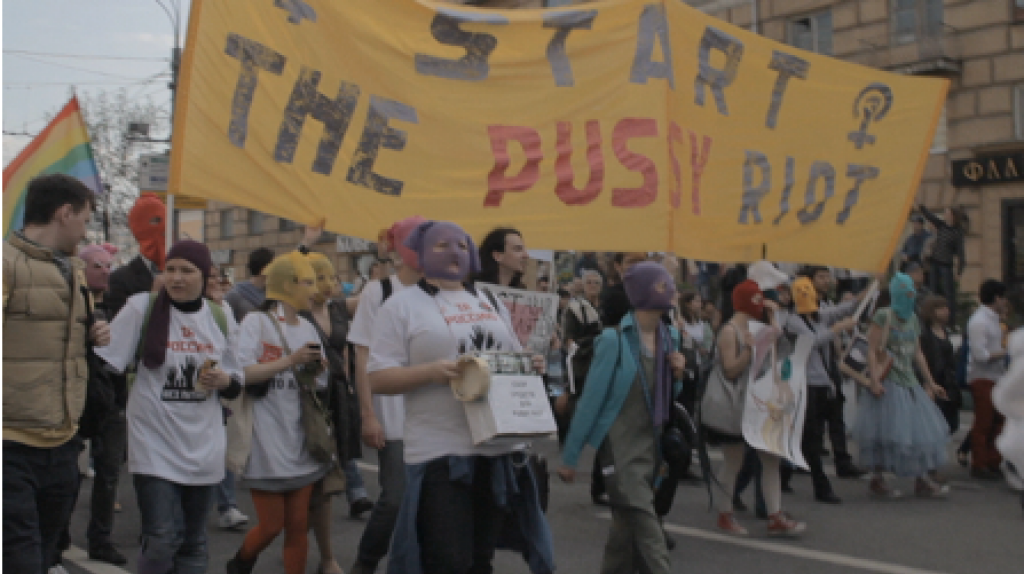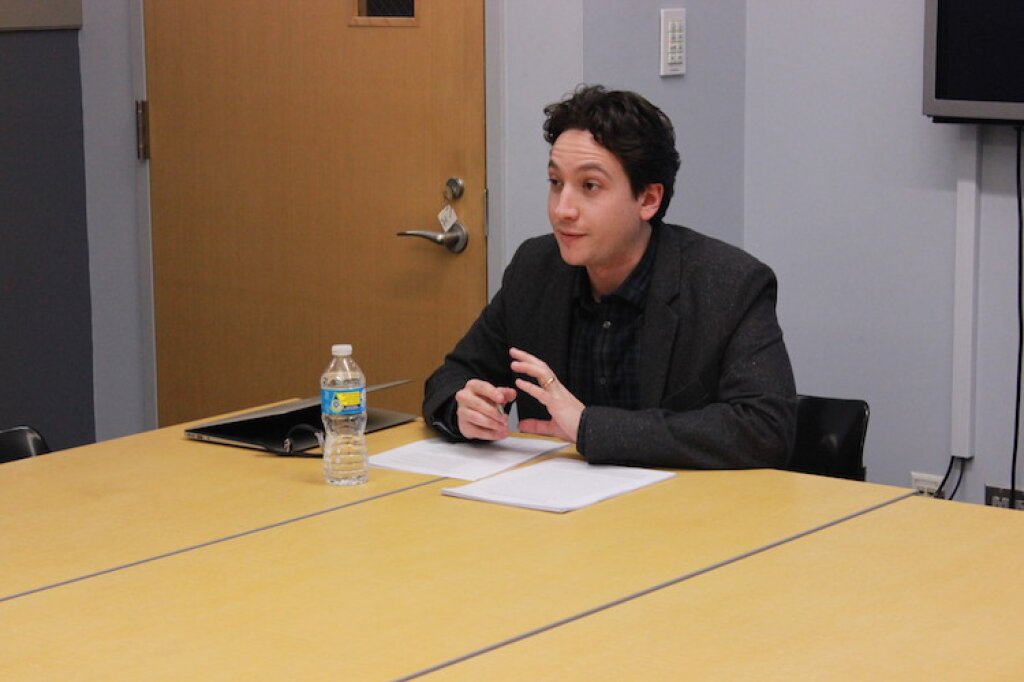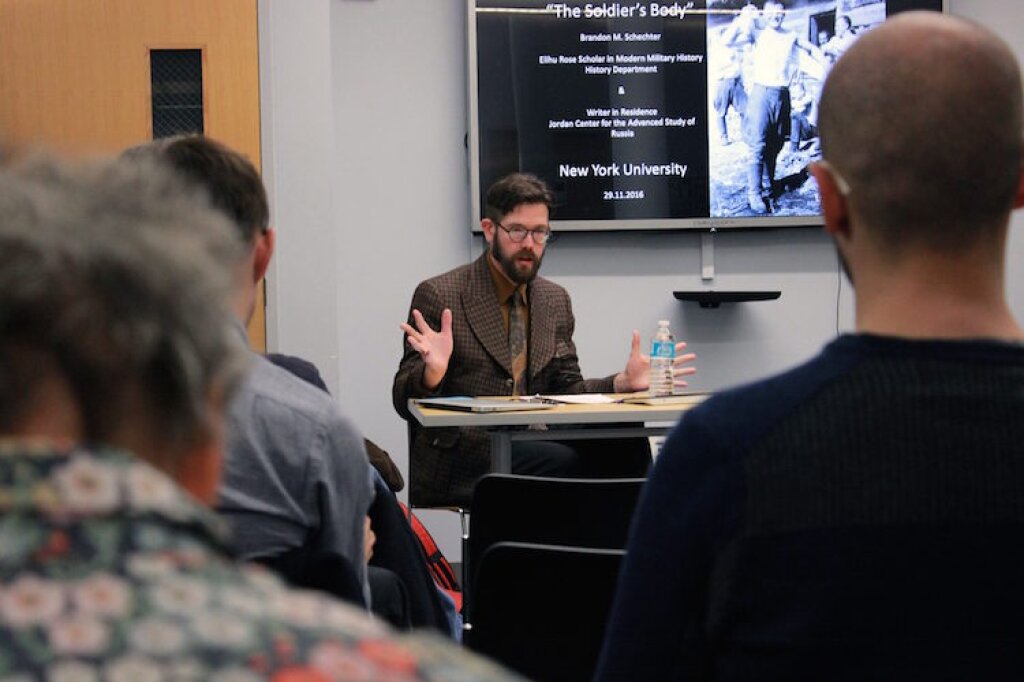On February 20th, the NYU Jordan Center hosted a film screening and discussion of Evgeny Mitta’s Act and Punishment, a documentary narrating the rise of the Russian punk feminist collective Pussy Riot. The event was moderated by Eliot Borenstein, Professor of Russian and Slavic Studies at NYU.
The film covers the rise of the collective as well as the personal narratives of members Nadya Tolokonnikova, Masha Alyokhina and Katya Samutsevich. 2008 saw the height of the Russian political street-art group, “Voina”, whose work was largely influenced by Russian writer and conceptual artist Dmitri Prigov. The group characterized its approach as “actionism”, a form of political messaging through the occupation of everyday spaces. Pussy Riot was similarly inspired by Prigov’s work but felt that Voina’s efforts were too “saturated with machismo”; it was time to engage in actionism from a feminist perspective, and Pussy Riot was officially founded in 2011. The group's earliest demonstrations consisted of such radical acts as the “Biological Museum”, performing in front of a prison and spontaneously kissing police officers in metro stations.
The unconventional approach taken by the collective is based on a “call for immediacy”, as Nadya notes. The goal of actionism is to actively occupy real spaces and engage people in shocking ways; unlike such forms of political activism as petitions, which require time and critical thinking by the public, actionism succeeds in engaging people in the moment. The anonymity reinforced by their colorful balaclavas adds another layer to the group’s work. Irony functions at the center of the group’s actions and it is something, as Nadya notes, that helps one “grow.”
This sense of irony is most poignant in Pussy Riot’s choice of occupied spaces. The most radical of these choices took the forms of Red Square and the Church of Christ the Savior in Moscow. While a common space for demonstrations historically, Red Square is also one of the most heavily guarded spaces in Moscow. Nonetheless, officers were quite baffled by Pussy Riot’s performance and did not even know how to make sense of it. Was this a form of extremism or something else entirely? This lack of sense making is part of Pussy Riot’s intention; the unconventional approach generates a shock to the system that leads one to question traditional notions of space and personhood. The Red Square performance represented a major turning point for Pussy Riot and triggered the evolution of the collective’s efforts into a global movement. The peak of the group’s efforts was the “Punk Prayer” performance in the Church of Christ the Savior on February 21st, 2012. Conducting such an unconventional political act within the sacred space of a church relayed a strong message to Putin and the Russian government. The government responded accordingly by sentencing Nadya, Masha and Katya to two years in jail. This extreme response illustrates the intimate relationship between Russia’s “cult of power” and religious authority. Pussy Riot’s demonstrations continue the tradition of “holy fools who broke the rules” throughout Russian history, according to art curator Elena Volkova. Such “holy fools” aimed to represent the “voice of the people” by exposing human vices, particularly those associated with Russia’s rulers. In spite of the religious backlash, however, the state was powerless to halt the transformation of Pussy Riot’s work into a world movement. While the impact of the collective’s work may not yet be visible in major ways, the final words of Nadya’s court statement still reverberate globally: “Open all doors, take off your epaulettes, and breathe with us the air of freedom.”
The screening was followed by a Q and A with Mitta, led by Professor Borenstein:
How difficult was it to get access to the Pussy Riot members?
Mitta noted that he has known the collective for many years and establishing closer relations was part of the process in filming the group’s demonstrations on the streets and engaging their large community of supporters. Pussy Riot’s development occurred through very unorthodox forms. After Voina, there was a strong push for the presence of a feminist collective and so Pussy Riot’s approach took the forms of punk rock, media activism and actionism. It was only after they had established their presence through these unorthodox back channels that their story was picked up by big media. Mitta thus had the opportunity to see the group’s development from its early stages.
Was the film released in Russia?
Yes, but the release required permission so the process was quite complicated. The film was successfully shown, however, on the program “Current Time”, Radio Svoboda and at Alexei Navalny’s headquarters.
Would you say Pussy Riot’s efforts have been successful?
It is difficult to characterize “success” in the traditional sense here because as contemporary artists, the approach and style of the collective is quite independent of anyone else. Not only is their performance art quite radical, but they are also very media oriented. Additionally, they combine this media presence with direct action on the streets, so they really cover all bases. In this sense, in existing separately from any official art institutions, their work is quite unique and in many ways, stands in its own category.
What is the group’s current status?
By this point, the members have gone their separate ways but are still engaging in activist work individually. Masha, for example, has published a book and all the members have continued performing and touring in various capacities. They have also appeared on MediaZona.



